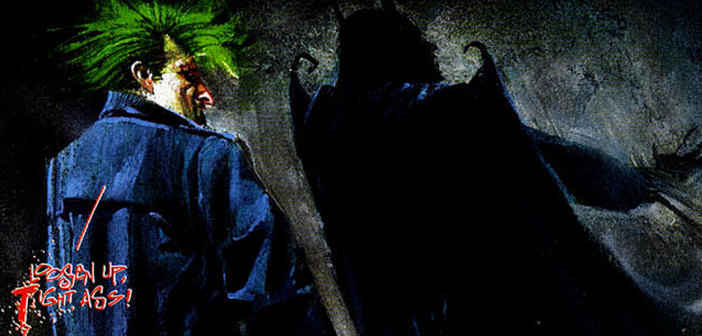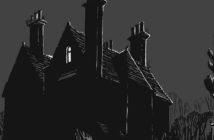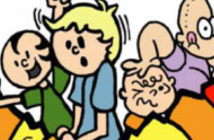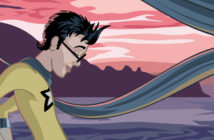Shadows veiled Arkham Asylum as Batman arrived to meet the demands of the institution’s rioting inmates. Coaxed by the psychotic Joker, the dark knight was given only one opportunity to rescue the riot’s hostages—by entering the asylum’s black halls alone to face all of his crazed adversaries. “A nice little game of hide-and-seek,” the Joker cackled. “You have one hour, sweetheart, and there’s no way out of the building. There’s the Scarecrow and Mr. Clayface and the strange Dr. Destiny, of course. Don’t forget Croc—he came up out of the damp, dark cellar this morning dragging his chains behind him. Now, Batman… the game ends at midnight. Run!” As the Joker laughed and screamed, Batman vanished into the corridors beyond.
Arkham Asylum: A Serious House on Serious Earth hit the shelves in 1989, written by Grant Morrison and illustrated by Dave McKean. Not since Frank Miller’s The Dark Knight Returns (which appeared in four issues during 1986) has a creative force been so willing and so successful in their experimentations with the heart and spirit of Batman and the underworld of madness that surrounds him.
The plot focuses on an uprising at Arkham Asylum, one that was promised to escalate into a bloodbath if Batman did not surrender himself over to the institutions maddened patients. Upon arriving at Arkham, Batman does just that and takes the place of Arkham’s staff. The only people that remain are Dr. Cavendish, the asylum’s administrator, and a psychotherapist named Dr. Ruth Adams.
While trapped in Arkham, Batman is confronted by a majority of his old foes: Two-Face, a recovering patient that has been treated to no longer rely on his scarred coin in exchange for a tarot deck; Clayface, a decrepit man withering away from disease; Doctor Destiny, a cripple confined to a wheelchair; the Mad Hatter, a yammering child rapist; the Scarecrow, a spooky shade haunting Arkham’s halls; and Killer Croc, a draconic beast in search of a dark knight to battle it.
Intermittently laced throughout the story are the recollections of Amadeus Arkham, the son and heir of the asylum’s legacy. Told through broken journal entries, readers learn that Amadeus himself was continually haunted by madness as his mother fell into insanity and his family was butchered by one of his most violent patients. In the end, Amadeus himself eventually suffered from a broken mind and died casting spells in his cell, hoping to bind Arkham’s curse of lunacy.
While the textual plot of the story is fairly straight-forward, the power of Morrison’s tale exists wholly on a symbolic level. Batman’s exploration of Arkham’s nightmarish halls is a shadowy dance through a gallery of Jungian archetypes. Readers of the book are not introduced to the title’s standard cast of characters, but rather the symbols they represent. Peering into the minds and souls of Gotham’s crazed troupe, all of the villains locked away in Arkham are revealed at their deepest representative levels.
None stand out more than the Joker himself, who is easily portrayed at his best by Morrison and McKean, more so than in the pages of any other comic book—including Alan Moore’s “The Killing Joke” short story. Crazed and confusing, Morrison uses the villain to his fullest, having the courage to explore subtle but honest sexual tensions that appear throughout the history of the series. It is also in Arkham Asylum where Morrison goes so far as to explain the crazed clown’s insanity as a kind of super-human power unto itself, which is known as the “super-sanity.”
But the dream-like potency of Arkham Asylum would be crippled in its enthralling appeal if it were not for Dave McKean’s breathtaking artwork. Simultaneously beautiful and disturbing, McKean captures all of the story’s players on both their textual and symbolic levels with gallery-quality work that ratchets the “Batman” title far beyond its standard noir setting. The quality and style of the artist’s work pulls its viewers into something far deeper and far more hidden in all of our imaginations. And fitting with McKean’s artwork like a glove is the fantastic lettering of Gaspar Saladino, whose work, especially with the Joker’s dialogue, proves how much comic books are collaborative efforts that, in the end, produce wholly wonderful finished products.
As Arkham Asylum: A Serious House on Serious Earth nears its end and Batman’s epic descent into the underworld of madness is complete, it’s uncertain whether or not he has anymore more right to be on the outside than his locked-away enemies. Walking towards the front gates, Batman and the Joker appear together in an oddly delicious scene where the adversaries leave each other as friends would. “Parting in such sweet sorrow,” the Joker says, waving to Batman as he exits. “Enjoy yourself out there… in the asylum. Just don’t forget: if it ever gets too tough, there’s always a place for you here.”
This comic book review originally appeared on Broken Frontier on 01 January 2009.




